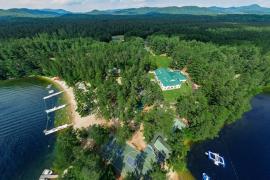Next to national, state, and municipal parks, camps manage some of our most important natural resources. Camp settings not only introduce children to natural resources, build their skills to recreate in those resources, but can also act as a model for sustainable practices. In the 2009 and 2011 surveys of camp directors, the American Camp Association (ACA) highlighted sustainability practices as a key emerging issue (ACA, 2012). As an issue on camp directors' minds, we must first start with defining this concept. Sustainability is defined in Webster's as "using a resource so that the resource is not depleted or permanently damaged." (Webster, 2015) In other words, sustainable practices are actions to help our camps' natural resources last. This is not a new concept, and while some camps focus on sustainability, it might be helpful to view how other fields (i.e., tourism and building industries) have implemented these practices. What sustainable strategies do tourism operators implement? Or when constructing a new building, what does the Leadership in Energy and Environmental Design (LEED) certification recommend for energy efficiency?
The Tourism Industry
For many years, the tourism industry has grappled with sustainable practices and their implementation. Some countries have developed sustainable certification programs to evaluate the sustainable practices of tourism companies. The Costa Rica Board of Tourism established the Certification for Sustainable Tourism (CST), a voluntary program that "seeks to categorize and certify each tourism company according to the degree to which its operations comply with a model of sustainability" (2015). This certification program is similar to ACA's accreditation standards and process. The CST program evaluates five aspects of the tourism company: physical-biological parameters, infrastructure and services, service management, external client, and socioeconomic environment. Through specific questions based on these aspects, the tourism company is rated with a five-tiered system in which a leaf represents each tier. The more leaves, the more sustainable the company. Through its CST program, Costa Rica endeavors to ensure to its visitors that sustainable environmental practices are in place with tourism venues. The CST criteria may be of help for camps wanting to implement sustainable strategies.
The Building Industry
The building industry's LEED program "is a green building certification program that recognizes best-in-class building strategies and practices (U.S. Green Building Council, 2015)." LEED offers five rating system groups to address different projects:
- Building design and construction
- Interior design and construction
- Building operations and maintenance
- Neighborhood development
- Homes
The four levels of LEED certification are Certified, Silver, Gold, and Platinum. So why have a LEED-certified building? According to the U.S. Green Building Council, "LEED certif ication means healthier, more productive places, reduced stress on the environment by encouraging energy and resource-efficient buildings, and savings from increased building value, higher lease rates, and decreased utility costs" (2015). The LEED certification can be used as not only a model for the camp industry, but also as a part of a camp's sustainable commitment.
The Camp Industry
Both the tourism and building industries have practices established that include criteria and implementation strategies. Camps could "borrow" these practices that best fit their mission and property. What is important to note is the process of implementing sustainability practices can be both quick and long-term. Camps must determine steps toward sustainable practices. While a LEED certification might be good, obtaining it can be expensive as well as daunting. Yet, by reviewing the LEED certification criteria, a camp could begin to implement sustainable strategies. Applying such practices in camp does not have to be difficult. While not all encompassing, following is a categorized list of some sustainable strategies (borrowed from the tourism industry) to consider implementing at camp. The categories include aspects related to a camp's human resources, food services, and conservation efforts.
Utilizing Staff for Sustainable Practices
A great way to implement sustainability practices in camp is to utilize its human resources. Many of the staff might be aware of and have a passion for sustainable practices. Capitalizing on staff knowledge of and commitment to sustainability can help get procedures in place and build momentum with campers. When thinking about how to utilize camp staff, consider the following ideas:
- Create a sustainability internship.
Seek out a student studying sustainability at a university. Have the intern examine present practices and create a plan to implement changes. - Form a sustainability committee.
On this committee have staff from all different areas of the camp, such as food services, transportation, maintenance, leadership staff, counselors, directors, and perhaps even camp advisory board members or local community members from outside the camp. Provide a directive to the committee that helps them focus on a specific area of change and develop a sustainable plan, policy, and actions. - Create a sustainability camp challenge or competition.
This could stay within your camp or include neighboring camps. Target staff to be in charge of this challenge. Some camps already have a program at the end of meals called an "Ort Report" (an ort is a morsel or scrap of food left over from a meal). Campers weigh the leftover food and liquid waste. The weight is then posted for all to see. The challenge is issued to not have any waste by the end of camp. Other challenges could be related to camp trash output, energy use, water use, and fuel. As with leftover food, take baseline measurements, then compare those baselines to acts of sustainability, such as creating a mountain from compostable products removed from the trash, including an energy awareness discussion, and promoting alternative transportation approaches.
Sustainable Strategies for Camp Food Services
In addition to providing quality food, a camp could consider its food services a venue for sustainable practice implementations, including:
- Grow food at camp
Parents and campers will eat it up literally! Teaching campers the food cycle may be as easy as taking an underutilized field and turning it into a garden space. - Composting
Recycle camp food, grass, and manure, turning it back into soil — the ultimate reuse of resources. Many camps already do this and can offer insights into the how-tos for composting. - Raise chickens
Raise chickens right off the composted foods and have fresh eggs to eat. Raising chickens also offers educational opportunities for campers; they can learn about life-cycles, food sources, and how fun chickens are to take care of. - Think local food
How is your relationship with the local community? Local communities offer a wealth of sustainable resources, such as buying food from a local farmer. Creating a mutually rewarding relationship between the farm and your camp may be just a farmer's market away. Try to locate Community Supported Agriculture (CSA) locales in your area and see if they are interested in working with you. Buying local improves the economy of your community and does wonders for public relations. - Assess sustainability practices to measure needs and progress
Sustainability calculators are available online to assist camps in this task (www.nature.org/greenliving/ carboncalculator). For example, what is the camp's carbon footprint? Or how far from your camp are your foods coming? Have you examined or considered travel and aging or preservatives that are used to keep items fresh? A food miles calculator (www.foodmiles.com) could be something that begins to create awareness and momentum for sustainable practices at your camp. For example, we used the food calculator to determine the distance our lunch avocado had gone from Mexico to our desk and found it had traveled 1,886 miles. This could be added incentive to getting your camp garden started. - Eliminate nonrecyclable products
Eliminate Styrofoam and other wasteful products. Move towards reusable dishware. - Reuse packaging
Food products often come with sturdy packaging. Not only can these items be recycled, but they have additional uses as reused materials for craft supplies, skit props, ceremonies, or even art projects. Russian camps reuse plastic bread bags for pom-poms/cheering materials for competitive events. They even use pop bottles for floating ceremonial fires. Be creative!
Conservation Practices for Camp
Taking care of camp property is a big task. As a camp replaces infrastructure (from a light bulb to septic systems), several sustainable practice strategies could be employed:
- Lighting
Are the camp's dishwashers, toilets, and laundry systems energy and water conservation products? Have you upgraded your lighting systems? Just as we change our incandescent light bulbs in our homes to compact fluorescent light bulbs (CFL), perhaps your cafeteria lighting needs updating too. No need to overhaul the entire system — this can be done one burned-out light bulb at a time. While visiting an eco-lodge in Costa Rica with a sustainability rating of three out of five leaves, the owner mentioned that it took them three years to get their lighting totally sustainable. - Greywater
Are you using the greywater from your toilet system to its full advantage? Greywater is gently used water from your bathroom sinks, showers, tubs, and washing machines. It is not water that has come in contact with feces and can be reused in numerous ways. Before you put in that new bath house, consider collection and uses for your greywater such as watering trees. - Collecting rainwater
Are you collecting rain water off your buildings for watering your sports fields, gardens, and other similar uses? Be sure to check state laws regarding rainwater harvesting — surprisingly, it is illegal in some states. - Xeriscaping
Xeriscaping is defined as "quality landscaping that conserves water and protects the environment" (Xeriscape, 2015). Are you planting native species that require less water, or have you considered xeriscaping property that you mow regularly? A permanent rock garden requires little to no maintenance, not only saving natural resources but the cost of human resources. - Conservation retrofits
Have you considered installing conservation retrofits such as low-flow plumbing and dual button f lush toilets to conserve water? - Eco-friendly cleaning supplies
Use eco-friendly cleaning supplies to protect the campers and the environment, for example vinegar and water can replace most cleaning supplies. - Early morning dip
Why not go for a swim instead of showering sometimes? Encourage campers and staff to shower two or three times a week rather than every day. - Reusable energy purchase options
There are numerous options to consider as sustainable energy practices for camps. Ask your present energy provider if it offers reusable energy purchase options to buy alternative sourced energy. Many energy companies offer energy audit examinations for free, and they may offer special energy purchasing plans and bulk energy purchases that will reduce your bills. - Installing alternative sources of power (e.g., solar, wind)
Investing in solar or wind power may be a good option for some camps, especially with the improvements in battery energy storage options. Some energy companies are looking for land to rent on which they can place large solar fields or windmills, and this may be a viable option for some. Have you checked out available solar composting toilets? They are clean, odor-free, and ideal for remote locations and potentially even cabin use. Using a rooftop, solar water heating system to supplement water heating has also become popular. These systems are not terribly expensive and may be ideal for east-facing buildings with few surrounding trees. - Create an energy conservation plan
Has your camp created an energy conservation plan where staff and campers are trained to conserve whenever possible, such as a turn-it-off-when-youleave- the-room/cabin energy policy? - Monitor greenhouse gases and your carbon footprint
Have you ever gone to the Environmental Protection Agency (EPA) website and calculated your camp's carbon footprint? This site, www3.epa.gov/ carbon-footprint-calculator, walks you through the steps for a home, which can easily be applied to a camp. The site also allows you to download the data to Excel to track the camp's changes. You could even make your camp carbon neutral by planting trees or maintaining forest area to offset your carbon footprint. - Selling carbon offsets
Camps often do a great job not polluting the air, and some may even be able to sell their carbon offsets to organizations that are doing a poor job. - Transportation
Consider modifying your camp's fleet of vehicles to those with the latest advances in energy efficiency. You can choose from hybrids, those that use natural gas, and electric vehicles.
Additional Conservation Strategies
There are many additional conservation strategies like re-using unclaimed lost and found items for rags, quilts, and arts and crafts projects. Additionally, try implementing leave no trace practices (Leave No Trace Center for Outdoor Ethics, 2015) at camp as there is no cost involved. Other strategies include purchasing products with the least amount of packaging, buying in bulk, buying "used" when appropriate, and lastly, throughout all programing and purchasing, whenever possible eliminate, paper products.
Get Started
Many more strategies can be incorporated into the camp setting but, for now, these should get you started. Consider implementing one strategy at a time. Visit businesses with sustainable practices in place. For example, new national park and state park facilities often are LEED certified or act as demonstration areas for sustainable technology/practices. Network with fellow camp directors whose camps are implementing sustainable practices. They have experience and can provide insights into the costs and benefits for a camp.
While a few of these strategies may be very costly and not for all camps, some of these changes may cost you nothing. Most camps can easily add sustainability practices to their mission statement. If everyone works toward sustainability, your camp will succeed.
Photo Davis Family YMCA Day Camp, Boardman, Ohio
References
American Camp Association (2012). Emerging issues. Retrieved from www.ACAcamps.org/ research/improve/emerging-issues Costa Rica Board of Tourism (2014). Certification for sustainable tourism. Retrieved from www.tourismo-sostenible.co.cr/EN/ sobreCST/about-cst.shtml Leave No Trace Center for Outdoor Ethics (2015). Leave No Trace. Retrieved from https://lnt.org U.S. Green Building Council (2015). USGRBC. Retrieved from www.usgbc.org/LEED/#overview U.S. Green Building Council (2015). Why LEED? Retrieved from http://leed.usgbc.org/leed.html Webster (2015). The Merriam-Webster dictionary (11th Edition). Springfield, MA: Merriam-Webster. Xeriscape (2015). Xeriscape. Retrieved from http://xeriscape.sustainablesources.com
Erik Rabinowitz, PhD, is the director and an associate professor of Recreation Management in the Department of Recreation Management and Physical Education at Appalachian State University.
J. Joy James, PhD, is Recreation Management faculty at Appalachian State University. She has been involved in teaching, resident camps, and environmental education, and has experience internationally with camps in Russia and Ukraine.




